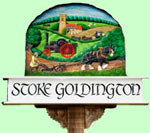THE OCCUPANTS OF GAYHURST HOUSE
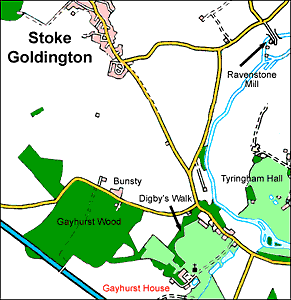
The present day Gayhurst Court is an Elizabethan addition to a Tudor house which, with its outbuildings, stood on the site of a manor house of much earlier origins. Alterations were made during the reigns of Queen Anne and Queen Victoria by owners wishing to leave their mark.
As social circumstances changed, it was used during World War for intelligence operations and subsequently as a warehouse and a boys’ school.
The estate was split and the house was sold off to developers in the 1970s and is now divided into freehold apartments and houses, three of which are newly built.
The present population of fifty could well be similar to previous eras when staff would have filled the upper floors of the house and most of the adjacent village.
However the manor is steeped in history, with many colourful characters having lived there:-
The Roman Period
In Roman England, according to Pevsner, Gayhurst was close to two important roads, but little evidence is available.
The road from Irchester to Olney, only five miles to the north-east, next picked up in Gayhurst Park where it went towards Hill Farm where there was an extensive settlement.
It crossed the river Ouse to the west of a large villa of Stanton Low and intersected Watling Street just north-east of Dovecote, the site of another villa. Traced on to a map, this makes a straight line typical of a Roman road, that could have crossed the park.
However the Buckinghamshire County Museum cannot confirm that the Roman road traversed the park; the view held is that it might have passed through Gayhurst Wood to the north-west.
The Ordnance Survey map, Roman Britain 1991, shows a Roman villa at Gayhurst and several finds nearby but no road crossing the Gayhurst area.
Pre-Norman Conquest
Before the conquest, the property was held by Siric, who could sell it. He was Leofwine’s man, who was the brother of Harold II, the last of the Saxon Kings. They both died at Hastings in 1066.
The Norman Period – The de Nowers Family (1087 – 1408)
Gayhurst was recorded in King William’s Domesday Survey and appears in the Doomsday Book compiled in 1086 as ‘Gatehurst’, one of the many variations of its name, meaning Goat Wood.
We know from the Domesday Book that it was owned by the Bishop Odo of Bayeux, Earl of Kent and had been given to him as ‘Tenant In Chief’ by his step brother, William the Conqueror.
Odo’s lands passed to William Peveril, after his execution following his treason in 1087 and his tenant, Ralph de Nowers (otherwise Noers or Nodarus) took over in Gayhurst. The family held the estate for 321 years.
In 1265 Isabel de Goldington, granddaughter of Sir Peter de Goldington and sole heiress of Stoke Goldington, the neighbouring parish to the north, married Sir William de Nowers.
The two estates were thereby joined and remained so until the Great Sale in 1912.
The Nevill Family (1408 – 1581)
In 1408 the sole heiress and sister to Almaric, the last de Nowers, married Sir Robert Nevill from County Leicester and the estate then stayed in the Nevill family for 173 years bringing the date to 1581.
It was probably the Nevills who built the oldest, Tudor part of the existing house in about 1500
The Mulsho Family (1581 – 1596)
On the death of Francis, the last of the male Nevills in 1581, the property was inherited by his sister Mary, who was then Mrs. Christopher Slingsby.
In 1581 Mary Nevill, sole heiress, married Thomas Mulsho of Thingdon (now Finedon) in Northamptonshire. By the earlier marriage she had a son, William, and the Slingsbys made a settlement on him.
To prevent any question of title arising, a patent was granted by Queen Elizabeth 1, conferring on Sir Francis Drake (amongst other property) the reversion to:-
“the Manor of Gothurste otherwise Gayhurste and Stoke Goldington. And also the advowsons gifts and rights of patronage of the Churches of Gothurste otherwise Gayhurste and Stoke Goldington aforesaid” should it become forfeited to the Crown.”

Sir Francis Drake
This deed was dated 13th January 1581. On the following day – 14th January 1581 – Sir Francis sold this reversion to William Mulsho, thus securing the title beyond dispute. (He may have needed the cash to finance future voyages)
Up to this time the house seems to have been quite a small mansion that faced west, the earliest part now standing having been built in about 1520 or a little earlier. A feature of this part is the original staircase. The steps are made of solid oak, but having become worn to a dangerous extent it became necessary (in 1912) to cover both risers and treads with oak boards, though some of the old steps at the very top were good enough to be left uncased. The upper windows of this old part retain what may be the original casements.
Mulsho enlarged the house turning it into its present shape. The new ‘E’ front facing South East instead of West, and a hollow courtyard walled on three sides on the North East.
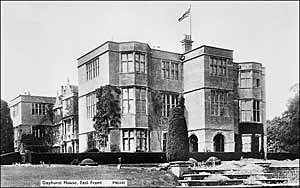
Gayhurst House – East Front
The Digby Family (1596 – 1704)
In 1596 Mary Mulsho, the daughter of William and his heiress, married Everard Digby and so started the Digby dynasty. He was later knighted but eventually hanged, drawn and quartered for his part in the Gunpowder Plot in 1605.
Before Queen Elizabeth’s death the catholic Digby’s had not been persecuted but, under James I, things changed for the worse and they had to worship in secret, celebrating mass in concealed attic chambers and underground retreats which could still be seen at Gayhurst into the 19th century.
There is no record of Guy Fawkes having actually visited Gayhurst, though it is extremely likely that he did. There is a deed in existence recording the sale by Sir Everard and Lady Digby of some land in order to raise funds for the Plot.
The door of the Digby Room was probably the front door of the 16th century house. (see below under “The Carrington Family”). It was found in a woodshed, restored and placed in its present position by Sir Walter Carlile.
The property was confiscated as a result of Sir Everard’s treachery but the estate had prudently been put in trusteeship and, by 1608 Lady Mary Digby obtained its restoration, an extraordinary achievement considering the enormity of her husband’s crime.
In the Calendar of Deeds relating to Gayhurst Estate 1325-1856 a remarkable manuscript, compiled for Walter Carlile between 1927 and 1928 from bundles of deeds found in the cellar, Lady Digby’s Judgement in the Court of Exchequer is related thus:
“And now namely on the Octave of St. Hilary in this Term, there comes hither into the Court a certain Mary Digby widow, late wife of the aforesaid Everard Digby, Knight, in her own person, being tenant of the Manors of Gayhurst and Stoke Goldington in the County of Buckinghamshire, which belonged to the aforesaid Everard named in that inquisition, and seeks a hearing of the aforesaid inquisition and it is read over to her, etc; on which reading, hearing and her understanding thereof she complains that she will be grievously distressed and troubled on account of the aforesaid inquisition; and that the aforesaid Manors of Gayhurst and Stoke Goldington with their appurtenances are unjustly taken into the King’s hands and retained, because protesting that Inquisition was by no means adequate in law for the same King to take in title the aforesaid manors with their appurtenances, by way of plea the same Mary says that long before the publication of the aforesaid act of the 3rd year of the reign of the said present lord king, a certain William Mulsho esquire was seized of the aforesaid.”
On 12th February 1625, at the age of 49, it is stated in the Calendar of Deeds that she was at last granted pardon by Charles ll.
Thus having the estates restored to her, at the age of 32 she was able to bring up her two young sons, Kenelm and John at Gayhurst.
Both sons had been knighted but Kenelm was said to be quite outstanding. Lipscomb tells us that he was born in 1603 and was sent to Oxford in 1618.
He did the grand tour of France, Spain, and Italy and on his return in 1623, was knighted by King Charles I.
Sir Kenelm restored the family’s reputation by “the uncommon merits of its successor”, wrote George Lipscomb.
By all accounts he was a charismatic and effective man, “but in 1636 he seceded to the Popish communion, and was placed under the care of Mr Thomas Allen, one of the most learned men of those times; who, discerning the natural strength of his faculties, directed him in the method of applying his wonderful capacity.”
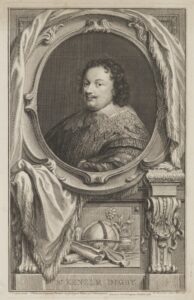
In his earlier days Sir Kenelm distinguished himself in the Navy, and it is said that the badge which appears on the pillars of the front door and on the bases of the pillars in the yew hedges in front of the house, consisting of three bolt heads and a ring under a rope sling, is a sign of his right to moor his barge at the Royal Steps at Greenwich and Westminster. Later he became a well-known courtier and greatly interested in astrology.
In the main hall of the house is a semi-circular doorway where above the flanking Corinthian pillars the monogrammed initials K.D. appear.
The Lady Venetia, Sir Kenelm’s wife, was a consumptive and it is believed that he imported edible snails (Helix Pomatia) from the South of France for her, as these were thought to have curative properties for this complaint. It is true that this species of snail is still occasionally found in the district
How Kenelm, with his religious commitment, subsequently managed to remain loyal to the Crown is not clear but he held influential posts such as Gentleman of the Bedchamber and Commissioner of the Navy and acquired great honour by his gallantry.
He “was a great benefactor to the Bodleian Library, by presenting to it, in 1633, a large collection of MSS” and was also the author of several learned books.
He espoused the cause of King Charles I but his negotiating powers seemed to avoid prolonged controversy with the Parliament of the Commonwealth, despite spells of imprisonment followed by exile in the Civil War.
It is very surprising that, having travelled so much in Europe in the service of the king, and with his knowledge of Renaissance culture and his interest in science and art, that there is little evidence that he carried out alterations at Gayhurst.
He died in 1665 leaving two sons, the second of whom, John Digby Esq. succeeded at Gayhurst.
Sir Kenelm’s brother Sir John and his eldest son (of his own name) were killed fighting for King Charles, and he himself was exiled after having been imprisoned. His second son John succeeded him, dying in 1673.
When John died in 1673 the property went to his two daughters, Margaret Maria and Charlotte, both of whom married men from the county of Flint, Sir John Conway and Richard Mostyn.
In 1704 John’s two sons-in-law obtained an Act of Parliament for the sale of the estate to George Wrighte, son of Sir Nathan Wrighte, Keeper of the Great Seal of England to Queen Anne.
This sale ended the continuous line of descendants in occupation since the Domesday survey, when Robert de Noyers (Nowers) had held the land, a period of 638 years (albeit that Gayhurst had been acquired three times through marriage over this time.)
Thomas Wright tabulated the early ownership, starting in 1087 when de Noyers changed from tenant to owner:
| Families who owned the estate by direct descent or marriage |
Years
|
|
| 1087 | Nowers |
321
|
| 1408 | Nevill |
173
|
| 1581 | Mulsho |
15
|
| 1596 | Digby |
108
|
|
Total
|
617
|
|
The Wrighte Family (1704 – 1830)
George Wrighte was born in 1677, the son of Sir Nathan Wrighte, Lord Keeper of the Great Seal of England, who was an extremely rich man. He bought the Manor of Gothurst, with Stoke Goldington, and the Advowson of both the Churches in 1704 for £27,000, and owned it until his death in 1724-5.
According to Lipscomb, George and his sister had been married very well by their father to very good fortunes”. He was made Clerk to the Crown by King William “for the sake of his father’s good services, and his own high merit.”
The next in a succession of three George Wrightes to own Gayhurst was his son, born about 1704, who died in 1766. He had St. Peters, Gayhurst Church, rebuilt in 1728 in pursuance of his father’s will, who had died in 1724.
It was this middle George Wrighte, “… a faithful judge, who retired to the country owing to the factions of the court,” who made improvements to the house, in Queen Anne style in 1725. He removed the village near the house down to the turnpike, the Newport Pagnell to Northampton road, and “…effected great improvements to the park.”
Horace Walpole attributes the park to Capability Brown before 1763, which is during the second George Wrighte’s ownership. It is possible that Brown carried out some work at Gayhurst just before he left Stowe in 1751.
Dorothy Stroud, in ‘Capability Brown’ wrote:-
“...During the preceding two years, however, he had been building up the foundation for his future practice by undertaking a group of commissions within a fifty-mile radius.”
Gayhurst is easily within that distance from Stowe so 1749-51 could have been the years of his involvement or, as Horace Walpole suggested, up until 1763.
The third and last George Wrighte to inherit Gayhurst was born about 1734 and died about 1804. It was this George who employed Humphry Repton in about 1793 to make proposals for the pleasure gardens and the park.
At the same time he proposed changes to the park at Tyringham, the property lying on the opposite bank of the River Great Ouse, which was built in 1796 by William Praed with John Soane as his architect.
The likelihood of Brown working at Gayhurst is strengthened by the date, 1751, and the signature found inside at the back of the pedestal supporting the vase over the Eyebath Spring at the end of Digby’s Walk. It is clear that this part of the landscape, down by the river, was frequented and considered to be of value.
It has a wonderful view over the valley on an elevated bank leading to the Bath House which is thought to have ancient origins. It could possibly be the site of the Roman villa at Gayhurst shown on the Ordnance Survey Roman map.
It was almost certainly George Wrighte who made further additions to the house, filling the courtyard on the North with the main staircase, the dining room, the ballroom above, and also building the stable block. The dovecote on the South beyond the stables is of an earlier date and is a lovely building complete with hundreds of nesting holes inside
The Wyndham Family (1830 -1842)
The only daughter of the last George Wrighte, Anne Barbara, born in 1784 remained unmarried and died in 1830. At this time Gayhurst had been in the Wrighte family for 126 years.
Anne left the property to a distant cousin, George Thomas Wyndham, whose young son died, leaving the property to his two aunts in 1837 – Maria Anne Wyndham, who married Lord Macdonald of Slate, and Cecilia, who married Lord Alfred Paget.
Lady Macdonald (1877 – 1882)
In 1842 the sisters let Gayhurst to the Honourable Robert Lord Carrington for five years. There are sales particulars to show that they considered putting it on the market in 1850, but they still owned it in 1854 when the estates were partitioned.
Gayhurst and Stoke Goldington then became the sole property of Maria, Lady Macdonald
Lady Maria Anne Macdonald was the last of the Wrightes, then let the house to Lord Carrington in about 1860 on a 21 years repairing lease.
Lord Robert Carrington (1842-1849 & 1860-1881)
Carrington, with the assistance of the architect Burgess, who was much in vogue at that time made considerable alterations and additions, mostly of a disastrous nature. The great kitchen built in the likeness of a Mediaeval refectory complete with a reader’s window high up in one wall, together with the round house at the back surmounted by the three headed dog Cerberus are the most obvious.
He also had the “painted room” panelled and decorated. The effect is startling in this setting but it has a charm of its own. It is executed on the lines of Catherine de Medici’s boudoir at the Chateau of Blois in France. In the original the flowers are stylised, but here they are in natural form and represent many local plants. Two French artists were brought over to do the work.
Lord Carrington also blocked up most of the secret passages with which the house was riddled, though part of one in the cellars still exists, as does also a hidden room between the floors in the centre of the building. An attic is still known as the oratory, the original window of which cannot be seen from outside as it is masked by a blank wall.
The “Digby Room”, now a bedroom over the porch on the East front, is immensely high. In the days of the Gunpowder Plot and religious persecutions it was divided into two by a false ceiling, the upper half being a hidden chamber connected to a passage in the thickness of the wall, which went down to the cellars, and with an exit through a revolving hearth stone in the fireplace of the room above. Lord Carrington had the false ceiling pulled down and the passage blocked.
On the left hand pillar of the main entrance is a roughly encased 1649 inscription C X and some doubtful initials. It is interesting to speculate as to whether this was done by a Roundhead (this part of the country was a Cromwellian stronghold) gloating over the downfall of a tyrant, OR by a Cavalier mourning the martyrdom of a saint – probably the former.
In 1882 Lady Macdonald, who during the five preceding years had resided at Gayhurst, sold the estates of Gayhurst and Stoke Goldington to James William Carlile Esq. of Ponsborne, Herts. having put it on the market again in 1881.
The Carlile Family (1882 – 1950)
James William Carlile owned the house for some twenty seven years and , on his death in 1909, he was succeeded by his son Walter, later Sir Walter Carlile, Bt., who stood as Conservative Member of Parliament for North Bucks from 1895 to 1906, and was the first Member of Parliament to arrive at the House of Commons in a motor car, having done much of his canvassing in a coach and four.
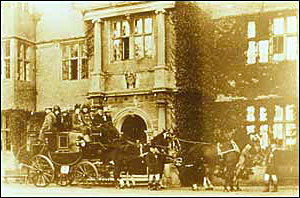 |
|
The Carlile Coach & Four
|
It was James Carlile who Thomas Wright visited in 1885 to gather material on Gayhurst for his book “The Town of Cowper or The Literary and Historical Associations of Olney and its Neighbourhood“.
Sir Walter Carlile, who was MP for North Bucks from 1895 to 1906, inherited the property from his father in 1909. He sold it to Lord Hesketh in 1931 but stayed on as life tenant until his death in 1950. His wife, Lady Elizabeth, continued to live in the house until its Redevelopment in the 1970s and then in the village until her death in 19****
Lord Hesketh – (1931)
WRENS – (1943-1945)
Rodbourne College – (1963-1969)
Click here for “Life Below Stairs” – an account of life in service at Gayhurst House between 1935 -1940 by Esther Wesley
